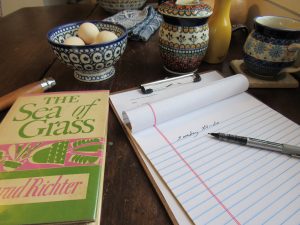Most of us have a similar recollection — the parent, grandparent, or great-grandparent who lived through the Great Depression, and as a result practiced thrift for the rest of their life. A journey through their cupboards revealed bundles of bread bags nestled next to stacks of neatly folded used foil. The hallway closet contained sacks of bows and ribbons from Christmases past, side by side with boxes of wrapping paper, carefully removed from each present and stored for future use. In the garage, sheds, workshops, or barn, a similar story: bucketloads of nails, washers, bolts, and nuts, perhaps even the apocryphal box labeled “String too short to be saved.”
The tendency to point to those acts of frugality and assume them to be an offshoot of the Great Depression is, of course, a fallacy. More likely, those thrifty characters were the last of a culture that ended with our post-war affluence, the last with their feet planted in a very different world.
As a model for life, we aspire on our farm to a culture of thriftiness (though we are too fully inculcated in today’s consumer world to truly make like it’s 1933, much less 1833). To our credit, we are often able to repurpose hardware, lumber, gates, used tractor oil, for additional uses, even getting three or four different meals out of a rooster. This note is about an evening we spent rolling coins, which is an act of thrift, of sorts, in that we saved ourselves an 11.9 percent fee at the Coinstar machine.
On a recent fall evening it was already dark by the time we ate supper at 6:30. Outside the temperature was dropping quickly into the upper forties. Cindy had prepared a tasty vegetable soup with the last of the summer produce, accompanied by grilled cheese sandwiches. We talked as we ate — of the day, of the need to worm a ewe the following morning — before tidying the kitchen.
With the domestic duties finished, I retrieved a heavy wooden cigar box, two large ceramic pigs, and a white candy jar imprinted in cobalt blue with the words Amarena Fabbri. Each container represented a strategic spot in the house, convenient to where one might undress or unload laundry and empty pockets of change. Over the course of two or three years, the various containers had filled with coins (as well as the ubiquitous pocket contents of a farm: fence staples, nuts and washers, a handful of .22 bullets).
The actual act of rolling coins and placing of them in paper sleeves is a simple job. The small challenge is in making time to do it. Like many such tasks, it is both helpful and more enjoyable to do it with someone else. As I began dumping the contents into a large roasting pan on the now clean kitchen table, Cindy made us each a cup of tea.
When sorting and rolling coins, it is easiest to first grab the largest, the quarters and, in this case, a couple of Susan B. Anthony dollars discovered in the pile. We talked a little while we worked but mainly sat in silence. Each assembling stacks of coins, then filling the paper tubes, we worked through the piles quickly. Within the hour we were again tidying the kitchen. I put the full rolls by the front door, the contents of which Cindy would deposit into our farm account. The final total was a little over $120. It was a fairly effortless task, one we could just as well have paid a machine to do. But we gained, apart from the addition to the farm funds, time to be together.
Later, the question going through my head as I went to sleep was this: How may these small acts of thrift — rolling coins, saving scrap lumber, reclaiming old fencing, canning produce, saving used Christmas bows — add up in our lives as compound interest that helps us keep our feet in a different world, a world we may need someday to return to?
………………………………………………………………….
Question: I am curious, what examples of thrift do you employ in your domestic economy?
Reading this weekend: Sea of Grass (C. Richter), a favorite novel, that I consider just about the perfect Western.
